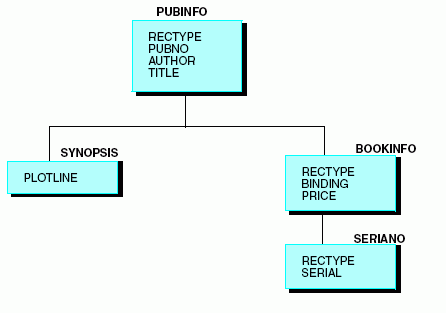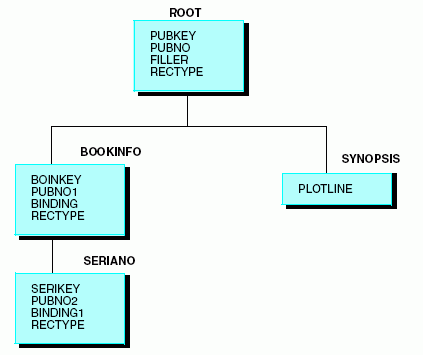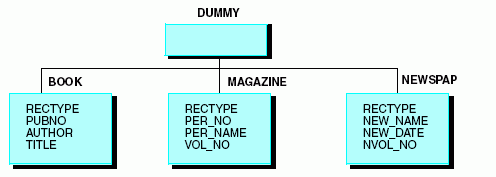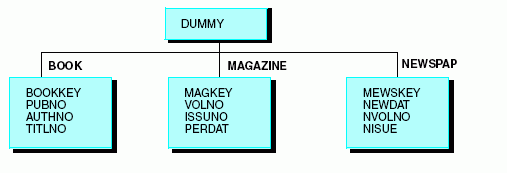Describing Positionally Related Records
The following diagram shows a more complex version of the library data source:

Information that is common to all copies of a given book (the identifying number, the author name, and its title) has the same record type. All of this information is assigned to the root segment in the Master File. The synopsis is common to all copies of a given book, but in this data source it is described as a series of repeating fields of ten characters each, in order to save space.
The synopsis is assigned to its own subordinate segment with an attribute of OCCURS=VARIABLE in the Master File. Although there are segments in the diagram to the right of the OCCURS=VARIABLE segment, OCCURS=VARIABLE is the rightmost segment within its own record type. Only segments with a RECTYPE that is different from the OCCURS=VARIABLE segment can appear to its right in the structure. Note also that the OCCURS=VARIABLE segment does not have a RECTYPE. This is because it is part of the same record as its parent segment.
Binding and price can vary among copies of a given title. For instance, the library may have two different versions of Pamela, one a paperback costing $7.95, the other a hardcover costing $15.50. These two fields are of a second record type, and are assigned to a descendant segment in the Master File.
Finally, every copy of the book in the library has its own identifying serial number, which is described in a field of record type S. In the Master File, this information is assigned to a segment that is a child of the segment containing the binding and price information.
Use the following Master File to describe this data source:
FILENAME = LIBRARY2, SUFFIX = FIX,$ SEGNAME = PUBINFO, SEGTYPE = S0,$ FIELDNAME = RECTYPE ,ALIAS = P ,USAGE = A1 ,ACTUAL = A1 ,$ FIELDNAME = PUBNO ,ALIAS = PN ,USAGE = A10 ,ACTUAL = A10 ,$ FIELDNAME = AUTHOR ,ALIAS = AT ,USAGE = A25 ,ACTUAL = A25 ,$ FIELDNAME = TITLE ,ALIAS = TL ,USAGE = A50 ,ACTUAL = A50 ,$ SEGNAME = SYNOPSIS, PARENT = PUBINFO, OCCURS = VARIABLE, SEGTYPE = S0,$ FIELDNAME = PLOTLINE ,ALIAS = PLOTL ,USAGE = A10 ,ACTUAL = A10 ,$ SEGNAME = BOOKINFO, PARENT = PUBINFO, SEGTYPE = S0,$ FIELDNAME = RECTYPE ,ALIAS = B ,USAGE = A1 ,ACTUAL = A1 ,$ FIELDNAME = BINDING ,ALIAS = BI ,USAGE = A1 ,ACTUAL = A1 ,$ FIELDNAME = PRICE ,ALIAS = PR ,USAGE = D8.2N ,ACTUAL = D8 ,$ SEGNAME = SERIANO, PARENT = BOOKINFO, SEGTYPE = S0,$ FIELDNAME = RECTYPE ,ALIAS = S ,USAGE = A1 ,ACTUAL = A1 ,$ FIELDNAME = SERIAL ,ALIAS = SN ,USAGE = A15 ,ACTUAL = A15 ,$
Note that each segment, except OCCURS, contains a field named RECTYPE and that the ALIAS for the field contains a unique value for each segment (P, B, and S). If there is a record in this data source with a RECTYPE other than P, B, or S, the record is ignored. The RECTYPE field must fall in the same physical location in each record.



